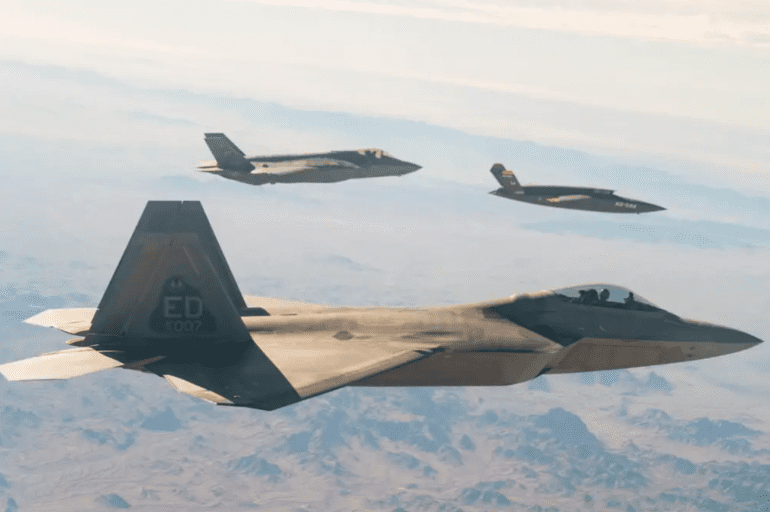TL;DR:
- The US Air Force seeks $5.8 billion to build around 2,000 AI-driven Valkyrie aircraft for advanced air dominance.
- The initiative focuses on creating 1,000 to 2,000 unmanned aircraft with AI pilots, led by the XQ-58A Valkyrie model.
- Valkyrie aircraft are designed to support human airmen, excel in high-risk scenarios, and autonomously strategize in simulations.
- The XQ-58A Valkyrie boasts impressive capabilities, including 550 mph cruising speed, 45,000 feet operational altitude, and 3,000 nautical miles range.
- The budget aims to cover expenses over five years, supported by years of Air Force testing and integration with AI programs.
- Ethical concerns arise as the initiative pushes the boundaries of autonomous warfare, prompting calls for international regulation.
- United Nations Secretary-General emphasizes the need to prohibit machines capable of autonomous lethal actions.
Main AI News:
In a groundbreaking move that underscores its commitment to shaping the future of air dominance, the United States Air Force is advocating for a substantial budget of $5.8 billion. This colossal allocation is intended to spearhead the construction of an impressive fleet comprising nearly 2,000 AI-driven Valkyrie aircraft. At the core of this strategic endeavor is the Air Force’s resolute vision for the next generation of aerial supremacy.
The focal point of this ambitious undertaking lies in the development of 1,000 to 2,000 unmanned aircraft, each equipped with cutting-edge AI pilots. The brainchild behind this concept is the XQ-58A Valkyrie aircraft—a trailblazing innovation set to redefine the very essence of aerial warfare. These AI-backed Valkyries are poised to serve as indispensable robotic companions to human airmen, capable of seamlessly weaving into complex scenarios where human pilots might face constraints. The potential for these aerial companions is particularly evident in high-risk missions where the return of a human pilot is doubtful.
The forthcoming phase of this initiative is set to unfold in the form of an intricate simulation. Over the Gulf of Mexico, the Valkyrie aircraft will engage in a meticulously orchestrated trial, orchestrating its own tactics to effectively pursue and neutralize designated targets. This leap into the realm of autonomous strategic thinking is poised to reshape the landscape of modern warfare.
Of paramount significance is the prowess exhibited by the XQ-58A Valkyrie model. Capable of maintaining an impressive cruising speed of 550 mph, this marvel can effortlessly reach operational altitudes of 45,000 feet, boasting a staggering range of 3,000 nautical miles. A departure from earlier models, such as the XB-70 Valkyrie bomber from the 1960s, which necessitated human pilots, the new Valkyrie’s automated capabilities have heralded a new era of unmanned flight. This transformation has culminated in a momentous shift towards cost-effectiveness, as each Valkyrie is projected to carry a price tag ranging from $3 million to $25 million—a fraction of the cost of a traditional manned pilot jet.
However, it’s important to note that this resolute vision for the future of air power has yet to garner the official approval of Congress. The proposed budgetary estimate of $5.8 billion, spanning a span of five years, serves as a testament to the gravity and ambition of this endeavor. Notably, the Valkyrie’s journey has been punctuated by rigorous testing and development, notably supporting F-22s, F-35s, and the Air Force’s visionary Skyborg program. This program, intertwined with artificial intelligence, is poised to revolutionize the management of unmanned aircraft, a paradigm that the Valkyrie perfectly exemplifies.
While the Air Force’s “Next Generation of Air Dominance” initiative garners broad support within military circles, the emergence of unmanned warfare has stirred ethical debates. Advocates of human rights, such as Mary Wareham of Human Rights Watch, are raising concerns about the moral implications of outsourcing lethal decisions to machines. Such deliberations harken to dystopian narratives reminiscent of science fiction. The involvement of AI in warfare prompts concerns about its potential to perpetuate rapid conflict escalation and even foster the creation of weapons of mass destruction.
The words of United Nations Secretary-General António Guterres resonate strongly in this context. As early as 2019, Guterres categorically stated that machines endowed with the power to take lives without human intervention are not only politically unacceptable but also morally reprehensible. He unequivocally calls for the prohibition of such technology through international law.
Conclusion:
The Air Force’s endeavor to develop AI-powered Valkyrie aircraft marks a transformative leap in modern air warfare. The integration of cutting-edge AI technology holds the potential to redefine strategies, yet raises ethical dilemmas requiring global attention and regulation. This initiative signifies a significant shift in the defense market, fostering advancements in AI technology and shaping discussions about the ethical boundaries of autonomous warfare.

